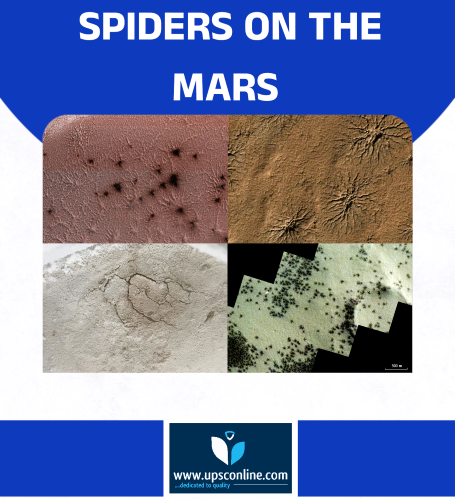The dendritic fractal patterns, like the branching pattern of tree roots or river drainage networks, are common on Earth. Recently, similar patterns have been detected on planetary surfaces such as Mars and Europa, the smallest of the four moons orbiting Jupiter.
Mars’ south polar “spiders” are thought to form via a solid-state-greenhouse effect, where gas trapped beneath seasonal carbon dioxide ice rushes towards a vent, scouring the substrate.
The National Aeronautics & Space Administration (NASA) have recreated the ubiquitous creepy black ‘spiders’ on the surface of Mars. These geological features, called araneiform terrain, can be seen at multiple locations on the Red Planet and are given the name ‘Spiders on Mars’.
There are hundreds of dark crack-like structures that appear on the surface of the planet with hundreds of lines or ‘legs’. The tightly grouped deformations can stretch to the lengths of over 3,300 feet (1,000 meters), and look like a hoard of spiders scurrying across the Martian landscape when viewed from space.
These ‘spiders’ were first spotted by Mars orbiters in 2003 which was a complete mystery at the beginning, but later it was found that these structures form when carbon dioxide (CO2) ice on the planet’s surface suddenly sublimates or turns the gas first melting into liquid.
The emerging gas, laden with dark dust, shoots up through cracks in the ice in the form of tall fountains or geysers, before falling back down and settling on the surface. This creates dark spots of between 45 m and 1 km across.
Mars Express image, creeping across towering hills and expansive plateaus. However, most can be seen as small spots in the dark region to the left, which sits just at the outskirts of a part of Mars nicknamed Inca City.
The reason for this name is no mystery, with the linear, almost geometric network of ridges being reminiscent of Inca ruins. More formally known as Angustus Labyrinthus, Inca City was discovered in 1972 by NASA’s Mariner 9 probe.
Recently a study was published in The Planetary Science Journal where researchers mimicked this process on a smaller scale using a specialised laboratory chamber creating a nearly perfect miniature version of the spiders.
The study was led by Lauren Mc Keown, a planetary geomorphologist at Nasa’s Jet Propulsion Laboratory (JPL) in California who has been recreating these spiders for over five years.
In another study, the Kieffer model test by recreating these steps in a wide barrel-size chamber at JPL, which is known as the Dirty Under-vacuum Simulation Testbed for Icy Environments (DUSTIE), which recreated Mars’s extremely low-ore and temperature — minus 301 degrees Fahrenheit (minus 185 degrees Celsius).
They simulated Martian soil into the chamber and covered it with CO2 ice. They then heated the mixture with a lamp placed beneath the simulated soil replicating the warming effect of the sun.
For this experiment, the researchers chilled Martian soil simulant in a container submerged within a liquid nitrogen bath. They placed it in the DUSTIE chamber, where the air pressure was reduced to be similar to that of Mars’ southern hemisphere. Carbon dioxide gas then flowed into the chamber and condensed from gas to ice over the course of three to five hours.
Once they got ice with the right properties, they placed a heater inside the chamber below the simulant to warm it up and crack the ice. They made use of an effect known as the Leidenfrost Effect, whereby if a substance comes in contact with a surface much hotter than its sublimation point, it will form a gaseous layer around itself.
When the block reached the sandy surface, CO2 turned directly from solid to gas and material was seen escaping through the central hole in the form of a plume.
They made use of an effect known as the Leidenfrost Effect, whereby if a substance comes in contact with a surface much hotter than its sublimation point, it will form a gaseous layer around itself. When the block reached the sandy surface, CO2 turned directly from solid to gas and material was seen escaping through the central hole in the form of a plume.
Temperatures in this region of Mars can dip as low as 300 degrees below zero, while the air pressure is less than 1/100th that of Earth’s.
According to NASA representative, It took many tries before Mc Keown found just the right conditions for the ice to become thick and translucent enough for the experiments to work. But finally, the ice cracked open and gas seeped out of the holder around 10 min before the frozen CO2 disappeared and left one of the iconic spiders. The spiders are connected to seasonal changes on Mars.
A new study reveals a hidden step in the Kieffer model: Ice also formed within the ground causing it to crack open along with the ice. It could explain why spider’s legs have such a zig-zag shape, the researchers said. Serina Diniega, a planetary scientist at JPL, who co-authored the study, issued a statement that reads, “It’s one of those details that show that nature is a little messier than the textbook image.”
According to the Kieffer model, Sunlight heats the soil when it shines through transparent slabs of carbon dioxide ice that built up on the Martian surface each winter. Being darker than the ice above it, the soil absorbs the heat & causes the ice closest to it to turn directly into carbon dioxide gas — without turning to liquid first — in a process called sublimation (the same process that sends clouds of “smoke” billowing up from dry ice).
As the gas builds in pressure, the Martian ice cracks, allowing the gas to escape. As it seeps upward, the gas takes with it a stream of dark dust and sand from the soil that lands on the surface of the ice.
When winter turns to spring and the remaining ice sublimates, according to the theory, the spider like scars from those small eruptions are what’s left behind.
There are still many questions about the spiders that can’t be answered in a lab. Why have they formed in some places on Mars but not others? Since they appear to result from seasonal changes that are still occurring, why don’t they seem to be growing in number or size over time?



0 Comments